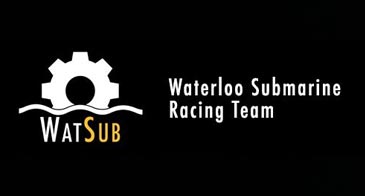User Case Study:
University of Waterloo Submarine Racing Team Uses Maple and MapleSim to Propel Them to New Depths







Challenge
The University of Waterloo Submarine Racing Team wanted a tool to help them improve and optimize their submarine design to create the fastest vehicle possible.
Solution
The team used Maple for various calculations, with a specific objective of analyzing undefined variables of the gearbox structure and optimizing the propeller components. They used MapleSim to optimize the submarine's transmission.
Result
Maple and MapleSim supported the development of an optimally-functioning submarine. The team, which now includes more than 130 members, launched their first Submarine in July 2016 and has competed in various competitions. They continue to refine their design and recently launched their second submarine, Bolt, for the 2017 competition season.
The greatest technical accomplishments are often born from a simple idea and a lot of ambition. Such is the case with the University of Waterloo Submarine Racing team (WatSub), which began as an engineering project in December 2014. The project eventually evolved into Ontario's first competitive submarine racing team, and appeared at its inaugural competition in July 2016. The team's submarine, affectionately named Amy, finished 11th overall out of a total of about 135 teams at the European International Submarine Races in Gosport, United Kingdom. The concept behind the submarine races is innovation in design and the development of a cross-functional team.
Gonzalo Espinoza, a co-founder of the WatSub project and the current hull subsystem lead, was formerly an international student at the University of Waterloo and founded the team while he was in his first year of Mechanical Engineering. He was focused on aerospace engineering at the time, but found the rocketry team was bound by strict competition rules and there wasn't as much freedom to innovate. He had no background with submarines, but was driven by the unique challenges the project presented. "I had been a member of different student teams for a full term at that point, and I realized that none of the teams was taking big risks or making bold design decisions," he said. "On top of that, most of the teams did not involve first-year students in their design decisions, so I realized if I wanted to be involved in a team with the pace and structure that I wanted, I would have to start my own."
 Members of the University of Waterloo Submarine Racing Team launch their new submarine, Bolt, for the 2017 competition season.
Members of the University of Waterloo Submarine Racing Team launch their new submarine, Bolt, for the 2017 competition season.
The WatSub team is focused on making the fastest human-powered submarine ever created, though their main priority is exploring new designs, technologies, and fabrication techniques that expose team members to unconventional experiences they would not get anywhere else. There is also a big social aspect to the team, with all members enjoying SCUBA diving and the rush that comes from meeting tight deadlines, Espinoza said. "There are a lot of unconventional things we do and all of it is done in-house, which I believe separates us from many other student teams at UW," he explained. "We drive a human-powered submarine in the school's pool, we sand-cast aluminium parts, thermoform parts, develop composite monocoques (a vehicle structure in which the chassis is integral with the body) on an annual basis, urethane cast parts, and basically any other process that our members can think of."
In developing Amy, the group used Maple to create a number-calculation platform, which supported optimization of structural components, calculation of acceleration and deceleration, and the determination of how much resin the team needed to use in the infusion of their monocoque. One of WatSub's specific objectives with Maple was to analyze the undefined variables of the gearbox structure to understand their trade-offs and generate data to sustain the final design intent. Held together by two truss members, the gearbox must support a static load with minimal deflection. Maple was also used to optimize the propeller components of the submarine, including pitch, sectional area, revolutions per minute (RPM) and blade diameter.
The team then used MapleSim to optimize the submarine's transmission, using similar parameters to a recent study conducting simulations for hydro electric vehicle powertrain models. "One of the reasons we prefer to work with Maple and MapleSim over the other platforms commercially available, is the support we receive from the Maplesoft team," Espinoza said. "Even with a team of students, we are able to access Maplesoft's resources to get the most out of their products and maximize on our hard work. The fact they are a local company speaks to the highly-talented community we are part of."
Since their first race in July 2016, the WatSub team has participated in other competitions and is constantly working on improving their designs. The team has grown to include more than 130 members and have developed Bolt, their second submarine, for the 2017 competitions.
The next step for the team is to create a Numerical-Simulations sub-team to study the vehicle dynamics of the submarine thoroughly, allowing the team to develop the vehicle to its maximum capabilities. "Our vehicle dynamic simulations are very basic at the moment - top speed, acceleration, braking distance - so there is a lot of room for improvement," Espinoza said. "We may not be able to improve our simulations overnight, but I foresee this being a huge opportunity to maximize on the use of Maple and MapleSim in the near future."
 Contact Maplesoft to learn how Maple or MapleSim can be used in your classroom.
Contact Maplesoft to learn how Maple or MapleSim can be used in your classroom.